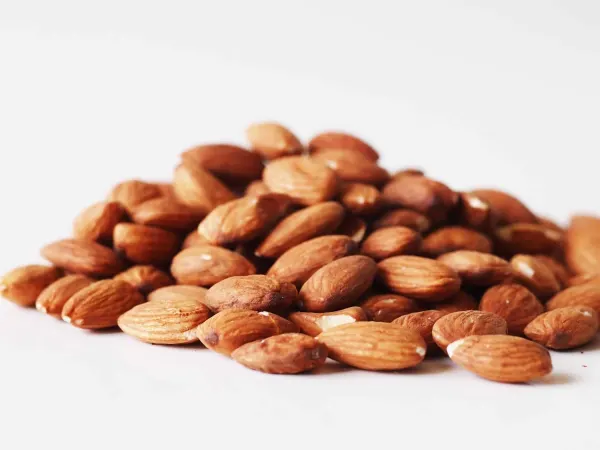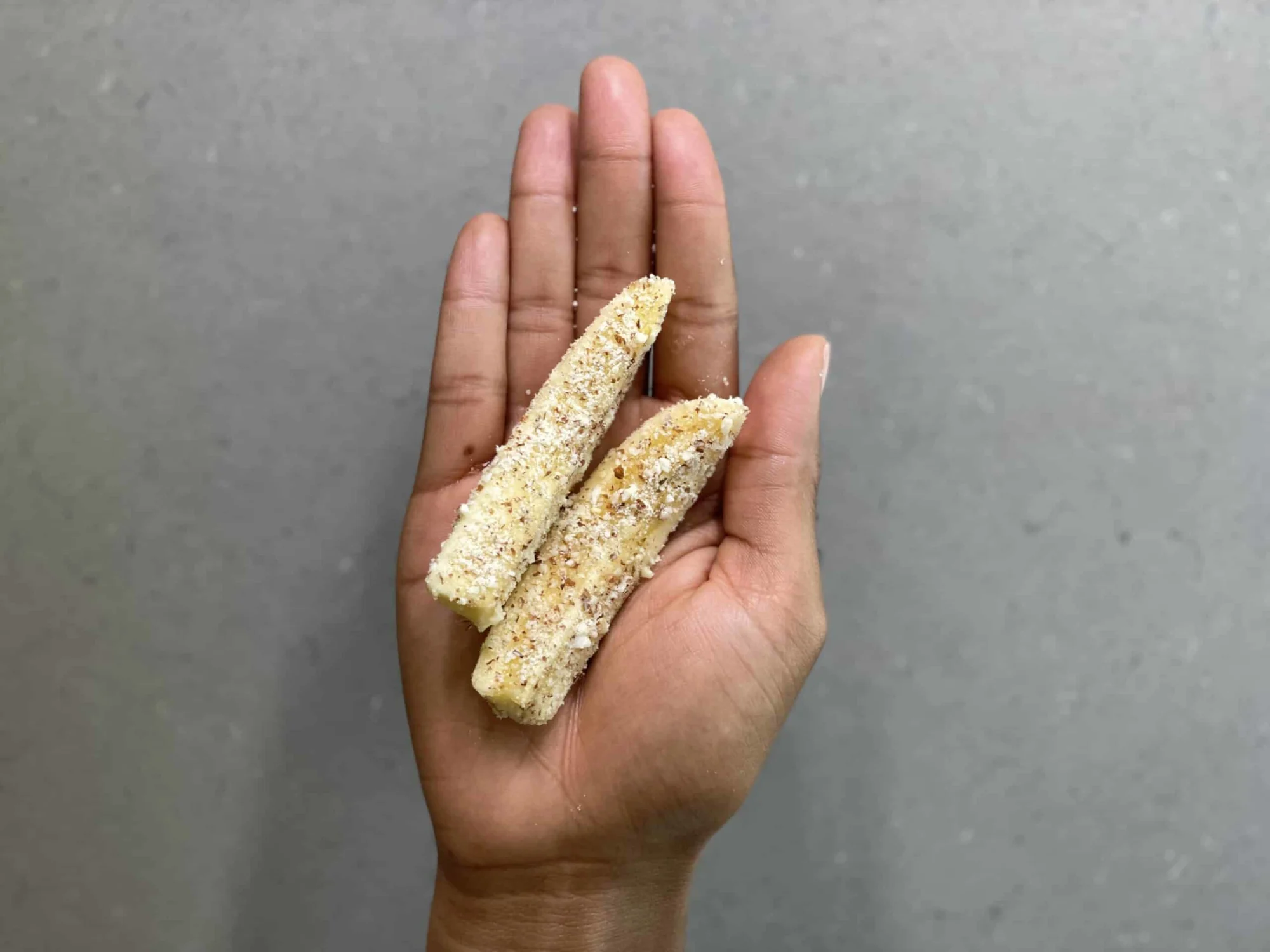Access our First Foods® Database in the Solid Starts App.
Learn moreAlmond
Tree Nut
Age Suggestion
6 months
Iron-Rich
Yes
Common Allergen
Yes

When can babies have almond?
Almonds, if they are finely ground or offered in the form of a smooth, thinned out nut butter, may be introduced as soon as baby is ready to start solids, which is generally around 6 months of age. Whole almonds, chopped almonds, and almond butter are choking hazards for babies and children, so read our preparation by age section closely before serving.
The almond may be one of the world’s most popular nuts, but botanically speaking, it is a seed. Like the pits of cherries, peaches, and plums, almonds are found at the center of a fruit that grows on a tree native to southwest Asia. The young fruits are known as green almonds, with soft edible flesh—just like its stone fruit cousins—that is celebrated as a seasonal treat in some cultures.
How do you serve almonds to babies?
Every baby develops on their own timeline, and the suggestions on how to cut or prepare particular foods are generalizations for a broad audience.
6 months old +:
Thin out smooth almond butter with water, breast milk, formula, or purees like applesauce and serve on its own or mix into other soft, scoopable foods like porridge or yogurt. You can also spread the thinned-out almond butter very thinly on toast strips. Try serving with a drink in an open cup to help wash down any sticky pieces of food. Finely grind almonds into a fine flour and sprinkle on other foods that it will stick well to (avocado, banana, etc.) Consider adding almond butter or almond flour to your batter when making pancakes, waffles, muffins, etc.
12 months old +:
Continue mixing smooth almond butter into yogurt, warm cereals, or baked goods, and sprinkling ground almond on other dishes and foods or mixing it into batter when preparing baked goods. Offer smooth almond butter thinly spread on toast. Try serving with a drink of water or milk to help wash down any sticky pieces of food. At this age, you may also introduce almond milk as an occasional drink. Read more in our Milk FAQs.
3 years old +:
Continue to serve finely ground almonds and smooth almond butter. If a child has developed mature eating skills (taking small bites with their teeth, chewing thoroughly before swallowing, not stuffing food in their mouth, and finally, the ability to identify and spit out foods when it is not well chewed, AND is able to eat softer nuts like walnut and pecans with ease, they may be ready to learn how to eat whole almonds. Just remember that nuts and nut pieces are considered choking hazards until age 4 and even beyond by all governing medical bodies. Almonds are particularly risky and challenging to eat as they are firm and difficult to take a bite out of--all of which increases choking risk. We'd recommend starting with other nuts before offering almonds.
Only serve nuts when your child is seated in an upright seat and is actively engaged in mealtime and not distracted. To model how to eat almonds safely, start by telling the child: "This is a hard one. Watch me." Then, show the toddler how to place the nut in-between your front teeth. Hold the nut between your teeth and exaggerate taking a small bite of the nut. Then, show how you move the nut piece to your molars with your tongue. Chew with your mouth open (you can even demonstrate by opening and closing your hands at the same time). Once you have chewed the nut well, open your mouth to show the toddler how it has been broken down. Say, "I moved it to my big strong teeth to chew it. It needs a lot of chewing." Demonstrate a couple of times before offering them an almond to do the same.
Then say, "Your turn to try." For the first attempt, firmly hold on to the nut for your child to take a bite from it (without you letting go of the nut). Do not put the nut in their mouth. Don't let go until they have used their teeth to actively take a bite. This ensures that they initiate chewing. Continue but only serve one or two nuts at a time to pace the practice. If the child insists on holding the almond themselves, allow them to self-feed and take a bite if you feel comfortable. If you do not feel comfortable or if the child does not bite or attempt to break down the almond, we recommend coaching the child to spit the nut out and waiting a few weeks more to practice chewing other nuts that are less challenging. After practicing nuts with a toddler, make sure their mouth is clear of food before letting them out of the chair.

Videos
Are almonds a choking hazard for babies?
Yes. Whole almonds are small, firm, and challenging to chew, and almond butter can be sticky, all qualities that increase the risk of choking. To reduce the risk, prepare and serve almonds and almond butter in an age-appropriate way as described in the How to Serve section. As always, create a safe eating environment and stay within reach of baby during meals.
Learn the signs of choking and more about choking first aid in our free guides, Infant Rescue and Toddler Rescue.
Are almonds a common allergen?
Yes, almonds are classified as a common allergen. Almonds are considered tree nuts (although they are technically seeds). While only 0.5% to 1.2% of the population is allergic to tree nuts, tree nut allergy is usually life-long: only 9% of children with tree nut allergy will outgrow it on their own. Although most reactions to almond are relatively mild, severe reactions have been reported.
Individuals with allergy to birch tree pollen may experience Oral Allergy Syndrome (also known as pollen-food allergy syndrome) after ingestion of almond, especially almond skin. Oral Allergy Syndrome results in localized symptoms of itching, tingling, or burning in the mouth after ingestion, but is unlikely to result in a severe reaction.
Although an allergy to one tree nut increases risk of allergy to another (individuals with almond allergy are more likely to be allergic to hazelnut, for example), keep in mind that being allergic to one nut does not necessarily mean that all nuts need to be removed from the diet. Having as diverse of a diet as possible, even within the confines of food allergies, is important for a child’s nutrition and quality of life. If your child has an almond allergy, work with an allergist to determine if other tree nuts can be safely incorporated into the diet.
For most babies, there is no need to pursue allergy testing before introducing tree nuts into the diet, even if there is a family history of food allergy. However, if baby has severe eczema or has already experienced an allergic reaction, or you suspect your baby may be allergic to nuts, make an appointment with your primary care clinician or a pediatric allergist before introducing almond at home. Your doctor can help you determine if almonds can be safely introduced in the home setting, or if supervised introduction in the clinic would be preferable. Interestingly, even in the context of positive allergy skin test or blood test, most individuals without a clear history of almond reaction will pass an almond challenge. Therefore, don't hesitate to pursue supervised almond introduction if it is recommended for your child. Keep in mind that a growing body of evidence supports the preventive benefits of early food allergen introduction (especially for babies with eczema), so it’s important not to delay introduction any longer than necessary.
When it’s time to introduce the nut at home, offer a small quantity (such as a pinch of finely ground nut of 1/8 teaspoon of smooth almond butter thinned with water, breast milk, or formula) at first. For step-by-step guidance on how to introduce almond and other common allergens, start your subscription in the Solid Starts App. Rather than filling the belly with the nut, it is important to maintain exposure to common food allergens (such as tree nuts) in the diet regularly (twice weekly, if possible) once introduced. Don’t stop offering the nut unless your baby shows signs of a reaction.
Are almonds healthy for babies?
Yes. Almonds offer nourishing fats, protein, some carbohydrates, and fiber. They also offer calcium, iron, magnesium, potassium, vitamin E, and zinc. Together, these nutrients provide energy to fuel baby’s growth, play, and exploration. They also support gut microbiome diversity, bone density, electrolyte balance, immune function, and taste perception. Plus, almonds are rich in health-supporting antioxidants for baby, particularly in almond skins.
Can babies have almond milk?
Yes—as an ingredient in solid food, but wait until after the first birthday to offer almond milk as a drink so it does not displace breast milk or formula, which offer important nutrition that baby needs to grow and thrive. After baby’s first birthday, almond milk may be offered as a drink, but keep in mind that many forms of almond milk can lack the nutrition growing toddlers need. If available, try to select kinds that are fortified with calcium and vitamin D. See our Milk FAQs to learn more.
Our Team
Written by
Expert Tips Delivered to Your Inbox
Sign up for weekly tips, recipes and more!
Copyright © 2025 • Solid Starts Inc







